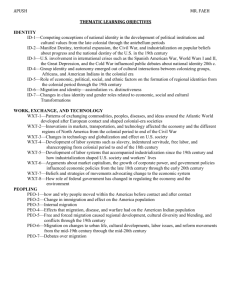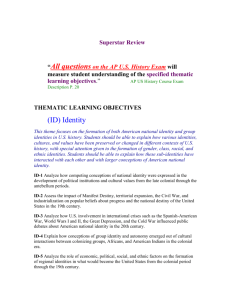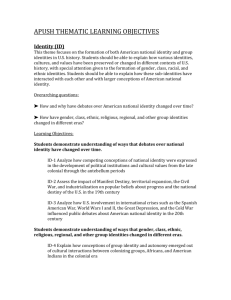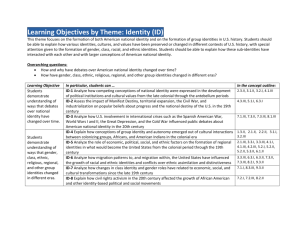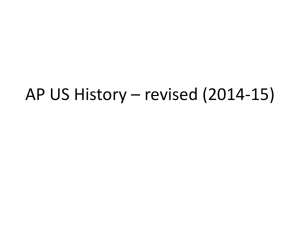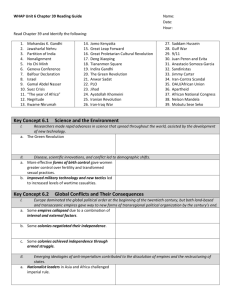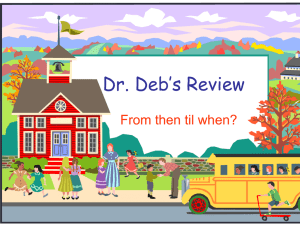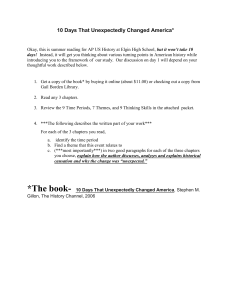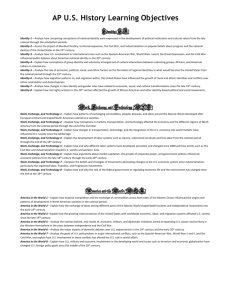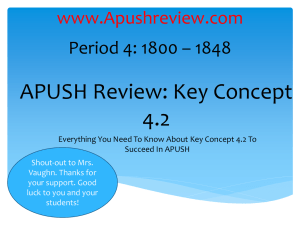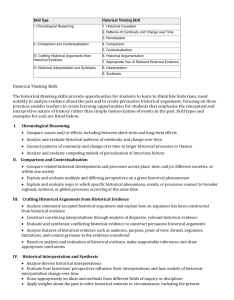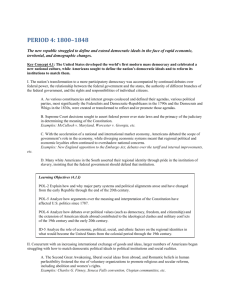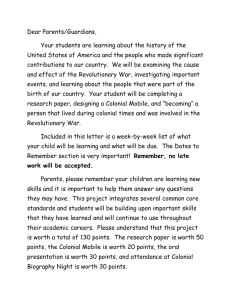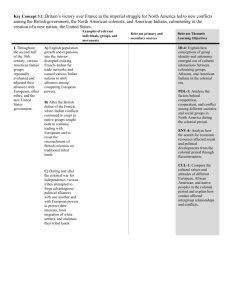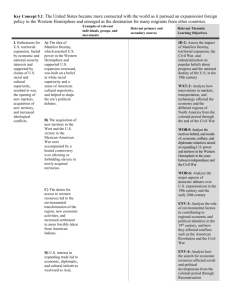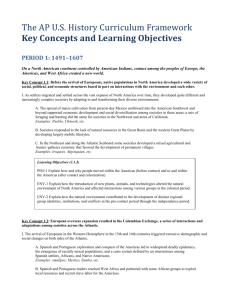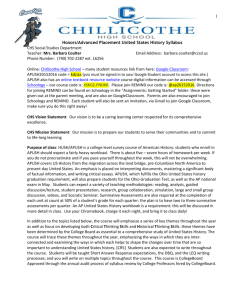EARLY YEARS – 1789-1815 GOAL #3 part II Key Concept 2: In the
advertisement
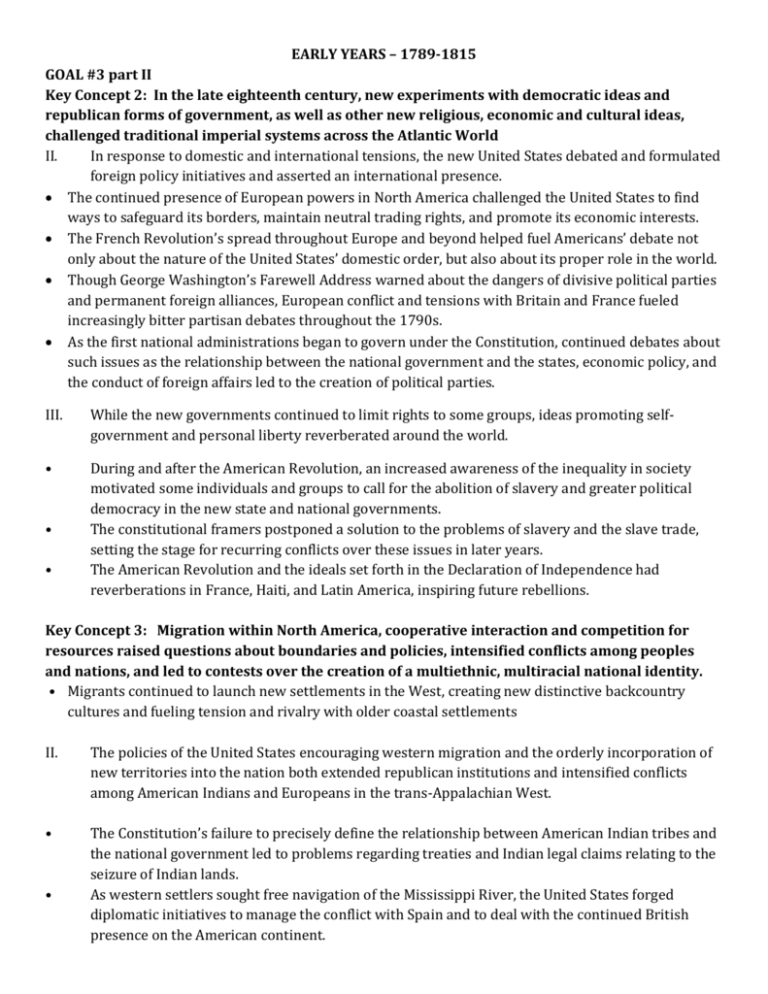
EARLY YEARS – 1789-1815 GOAL #3 part II Key Concept 2: In the late eighteenth century, new experiments with democratic ideas and republican forms of government, as well as other new religious, economic and cultural ideas, challenged traditional imperial systems across the Atlantic World II. In response to domestic and international tensions, the new United States debated and formulated foreign policy initiatives and asserted an international presence. The continued presence of European powers in North America challenged the United States to find ways to safeguard its borders, maintain neutral trading rights, and promote its economic interests. The French Revolution’s spread throughout Europe and beyond helped fuel Americans’ debate not only about the nature of the United States’ domestic order, but also about its proper role in the world. Though George Washington’s Farewell Address warned about the dangers of divisive political parties and permanent foreign alliances, European conflict and tensions with Britain and France fueled increasingly bitter partisan debates throughout the 1790s. As the first national administrations began to govern under the Constitution, continued debates about such issues as the relationship between the national government and the states, economic policy, and the conduct of foreign affairs led to the creation of political parties. III. While the new governments continued to limit rights to some groups, ideas promoting selfgovernment and personal liberty reverberated around the world. • During and after the American Revolution, an increased awareness of the inequality in society motivated some individuals and groups to call for the abolition of slavery and greater political democracy in the new state and national governments. The constitutional framers postponed a solution to the problems of slavery and the slave trade, setting the stage for recurring conflicts over these issues in later years. The American Revolution and the ideals set forth in the Declaration of Independence had reverberations in France, Haiti, and Latin America, inspiring future rebellions. • • Key Concept 3: Migration within North America, cooperative interaction and competition for resources raised questions about boundaries and policies, intensified conflicts among peoples and nations, and led to contests over the creation of a multiethnic, multiracial national identity. • Migrants continued to launch new settlements in the West, creating new distinctive backcountry cultures and fueling tension and rivalry with older coastal settlements II. The policies of the United States encouraging western migration and the orderly incorporation of new territories into the nation both extended republican institutions and intensified conflicts among American Indians and Europeans in the trans-Appalachian West. • The Constitution’s failure to precisely define the relationship between American Indian tribes and the national government led to problems regarding treaties and Indian legal claims relating to the seizure of Indian lands. As western settlers sought free navigation of the Mississippi River, the United States forged diplomatic initiatives to manage the conflict with Spain and to deal with the continued British presence on the American continent. • III. New voices for national identity challenged tendencies to cling to regional identities, contributing to the emergence of distinctly American cultural expressions. As national political institutions developed in the new United States, varying regionally-based positions on economic, political, social and foreign policy issues promoted the development of political parties. The expansion of slavery in the lower South and adjacent western lands, and its gradual disappearance elsewhere, began to create distinctive regional attitudes toward the institution. Enlightenment ideas and women’s experiences in the movement for independence promoted an ideal of “republican motherhood,” which called on white women to maintain and teach republican values within the family and granted women a new importance in American political culture. SYLLBUS FOR THE REMAINDER OF GOAL #3 For Monday October 6 – Have read in Portraits the Secret Lives of a Developing Nation For Tuesday October 7 – Have read the Whiskey Rebellion in Annual Editions. Make sure you bring your computers to class For Thursday October 9 - Brochure on the Political Party due– Have completed the brochures Political Brochures due – Pick a party- Democratic-Republicans or the Federalists – create a brochure that would encourage someone to join your party. BE CREATIVE – If you use computer do more than cut and paste *****. In order to complete this assignment you will need to read in the textbook pp. 208212 and look at the typed notes on my website. For Friday October 10 –have read What Price Free Speech? For Monday October 13 – QUIZ DAY For Tuesday October 14 – Read pp. 205-209 in The American Spirit. Answer the questions - to be posted by end 10/10 For Wednesday October 15 – Read in textbook – p. 214 – start with Migration p. 220 For Thursday October 16 – 20 min. 5 question quiz. For Friday October 17 - Read in textbook – p. 222- start with War of 1812 to p. 228 stop with John Marshall. For Monday October 20 – UNIT TEST Textbook chapters: 7 & 8 – Open and read sections you are having trouble with – look at the pictures and graphs Review Questions for the Entire Unit 1. Analyze how competing conceptions of national identity were expressed in the development of political institutions and cultural values from the colonial period through the 19th c. (ID-1) 2. Explain how conceptions of group identity and autonomy emerged out of cultural interactions between colonizing groups, Africans, and American Indians in the colonial era. (ID-4) 3. Analyze the role of economic, political, social, and ethnic factors on the formation of regional identities from the colonial period through the 19th century (ID-5) 4. Analyze how migration patterns to, and migration within, the US have influenced the growth of racial and ethnic identities and conflicts over ethnic assimilation and distinctiveness (ID-6) 5. Analyze how innovations in markets, transportation, and technology affected the economy and the different regions of North America from the colonial period through the end of the Civil War – (WXT2) 6. Explain the development of labor systems such as slavery, indentured servitude, and free labor from the colonial period through the end of the 18th century. (WXT-4) 7. Analyze the effects that migration, disease, and warfare had on the American Indian population after contact with Europeans (PEO) 8. Analyze how free and forced migration to and within different parts of North America caused regional development, cultural diversity and blending, and political and social conflicts throughout the 19th century (PEO-5) 9. Analyze the factors behind competition, cooperation, and conflict among different societies and social groups in North America during the colonial period. (POL-1) 10. Explain how activist groups and reform movements, such as antebellum reformers, civil rights activists, and social conservatives, have caused changes to state institutions and US Society – (POL3) 11. Analyze how arguments over the meaning and interpretation of the Constitution have affected US politics since 1787 (POL-5) 12. Explain how the exchange of ideas among different parts of the Atlantic World shaped belief synthesis and independence movements into the early 19th c. (WOR-2) 13. Analyze the motives behind, and results of, economic, military, and diplomatic initiatives aimed at expanding US power and territory in the Western Hemisphere in the years between independence and the Civil War – (WOR-5) 14. Explain how the natural environment contributed to the development of distinct regional group identities, institutions, and conflicts in the pre-contact period through the independence period (ENV1) 15. Analyze the role of environmental factors in contributing to regional economic and political identities in the 19th century and how they affected conflicts such as the American Revolution and the Civil War. (ENV-2) 16. Analyze the role of environmental factors in contributing to regional economic and political identities in the 19th century and how they affected conflicts such as the American Revolution and the Civil War. (ENV-3) 17. Analyze how emerging conceptions of national identity and democratic ideals shaped value systems, gender roles, and cultural movements in the late 18th century and the 19th century (CUL-2) 18. Analyze how changing religious ideals, Enlightenment beliefs, and republican thought shaped the politics, culture, and society of the colonial era through the early Republic (CUL-4)
